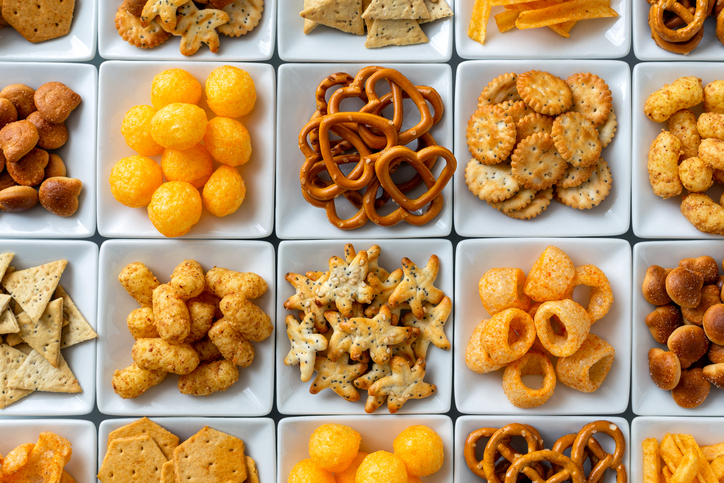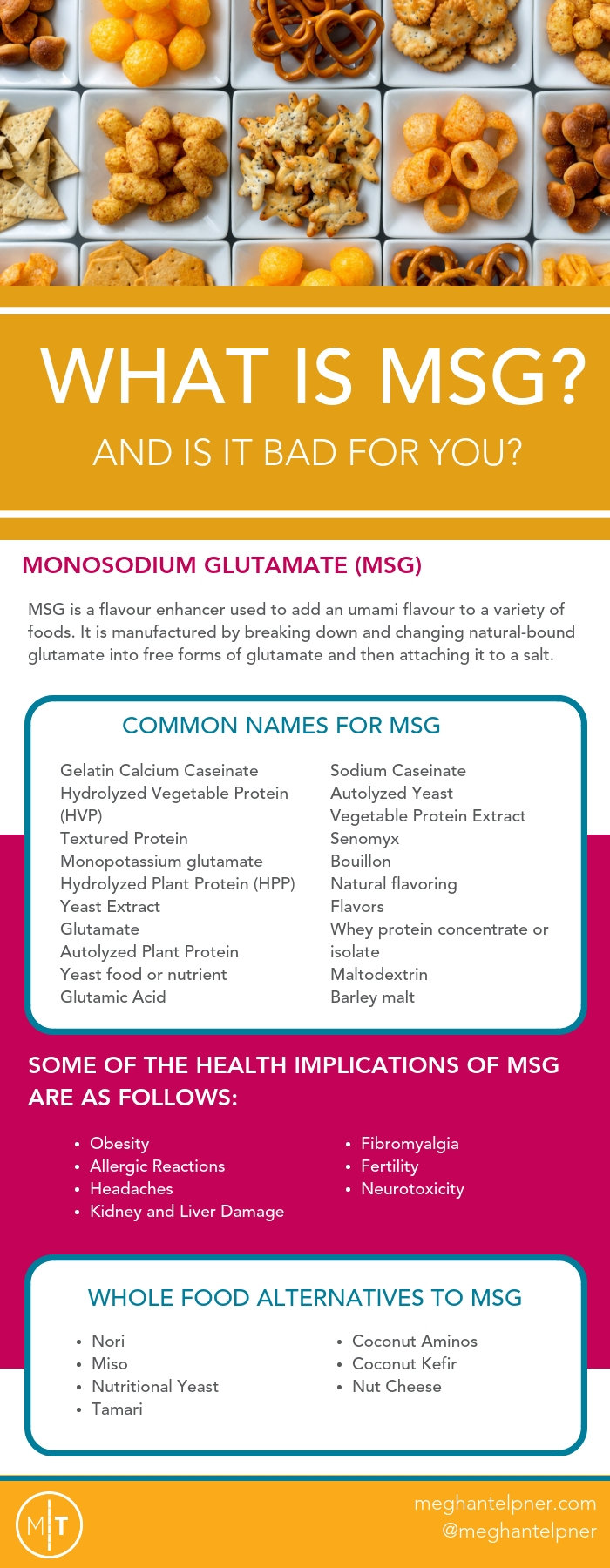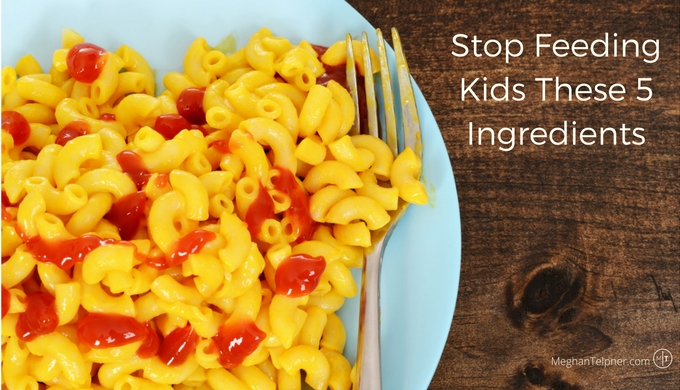Is MSG Bad For You and Should You Be Avoiding It?

Monosodium Glutamate (MSG) is my ultimate poison. Whenever I consume it, even in small amounts, I get a terrifying neurological reaction. I lose the ability to focus my eyes, and I have trouble speaking my thoughts. After some time, I get my vision back but then I experience complete numbness that moves from my hand – so that I can’t hold or carry anything – up my arm to my nose, tongue and lips. Once MSG makes it way through my system, I am left with a killer migraine and a buzzing that doesn’t let me sleep. I wake up the next day with what feels like the worst hangover of my life. Am I merely an isolated case, or is MSG bad for you too?
What is Monosodium Glutamate?
MSG is a flavour enhancer used to add an umami flavour to a variety of foods. Glutamic acid, or glutamate, is an amino acid that our body produces. It’s considered an excitatory amino acid because it has the ability to stimulate the nervous system. Monsodium glutamate, or MSG, is manufactured by breaking down and changing natural-bound glutamate into free forms of glutamate and then attaching it to a salt.
Bound or natural glutamates found in foods take longer for us to break down, digest and absorb. Free glutamates are absorbed much more quickly.
Some websites have cited that the neurological reactions of MSG are attributed to it passing through the blood-brain barrier. Others cite the reaction due to receptors in the mouth that are closely connected to receptors in the brain. In the book, Excitotoxins: The Taste That Kills, author Dr. Russell Blaylock states that MSG can contribute to the production of brain lesions, obesity, and brain damage.
Small amounts of MSG used to be relatively harmless. The challenge, however, is that over the past 50 years or so, MSG has been used in a massive variety of processed foods, conventional and organic under various names, and in higher and higher concentrations. In 2014, the global demand for MSG was about 3 million metric tons and that is anticipated to grow to 3.9 million metric tons by 2019 – it’s a billion dollar industry. Most of that consumption happens in Asia; however, here in North America MSG is present in many processed foods – and often in ways, we don’t expect, as you’ll see further along.
Health Effects of MSG
MSG is a chemical we should be avoiding. Though the evidence isn’t as clear-cut as it should seem given the number of people that suffer negative health effects from MSG consumption, as often happens with such additives, it is a reactionary food. For those who are sensitive, there is a definite immediate reaction and some argue that everyone is affected, but the effects build slowly over time. The fact remains that it has no nutritional value, much like other additives like food dyes, artificial colours, and artificial sweeteners, and is a potential detriment to our health, with some populations such as children and the elderly being at higher risk of adverse effects.
As it’s written in the Textbook Of Natural Medicine “monosodium glutamate is a well-recognized migraine trigger that can directly activate the NMDA receptor”. The NMDA receptor is a glutamate receptor found in nerve cells and is critical in synaptic plasticity, a cellular function that handles learning and memory.
The studies that proclaim that there is no neurological effect seem often to be criticized as just bad science. The American Nutrition Association explains it this way:
There are . . . double-blind studies suggesting that these amino acids are safe. A review of studies relevant to the safety and toxicity of glutamic acid, however, suggest that many of them are flawed.” For example, “in the case of MSG toxicology studies, the placebo used to test the excitotoxin glutamate is NutraSweet®, which contains the excitotoxin aspartate. It has been clearly shown in a multitude of studies that aspartate produces the identical destructive reactions on the nervous system as MSG.
Some of the health implications of MSG are as follows:
Obesity
MSG consumption has been linked to obesity. In one cross-sectional study of 752 women in China, researchers measured the amount of MSG cooks used at home. The women who consumed MSG were more likely to be overweight than those who didn’t eat it, leading the study’s authors to conclude that MSG may increase our risk of obesity. Another study had volunteers eat a savory soup, then one group was given a soup with added MSG and the control group received a second bowl of the original soup (without MSG). The MSG group described the second bowl as more pleasant and flavourful, and later had an increased desire for the soup and wanted to eat more later. This indicates that MSG can encourage appetite or train us to boost our hunger.
Animal studies have also used MSG to induce obesity, insulin resistance and fatty liver.
Also, while MSG is widely used as a cooking ingredient in other places in the world, here in North America most of us don’t have it in our kitchens. We have it in seasoning packets, processed foods and fast foods – and processed foods are already associated with obesity and cardiovascular disease risk factors like high cholesterol and hypertension.
Headaches
This is one of the most common complaints about MSG. Studies have shown that MSG can induce headaches in healthy people as well as migraine sufferers. One study of cell cultures noted that mature brain neurons were more sensitive to MSG than young neurons, and that MSG caused inflammation and swelling in those mature neurons, which is a possible explanation for the headaches experienced after we eat something with MSG.
Allergic Reactions
There is some evidence that consumption of MSG food additives are linked to:
- skin rashes
- convulsions
- numbness
- weakness
- flushing
- dermatitis
- abdominal discomfort
- headache
- atopic dermatitis
- asthma
Kidney and Liver Damage
In animal models, MSG is associated with fatty liver, non-alcoholic fatty liver disease, kidney damage and oxidative stress (that can lead to kidney damage).
Fibromyalgia
In one study, researchers gave one group of patients with fibromyalgia MSG and another group a placebo. The group who took MSG noted they received a more significant return of symptoms and decreased the quality of life compared to those who didn’t. The Textbook of Natural Medicine also lists the removal of MSG from the diet as being associated with a reduction in symptoms.
Fertility
Animal models indicate that MSG can disrupt the reproductive system, affecting both female ovaries and male sperm count. As Blaylock writes in Excitoxins, The Taste That Kills, “Not only have many experiments shown that excitotoxins in the diet cause major endocrine problems but also an experiment giving MSG to pregnant mice has shown similar injuries in the offspring, confirming that glutamate passes across the barrier of the placenta and enters the fetal bloodstream.”
Neurotoxicity
Animal studies have indicated that MSG may have a neurotoxic effect on the brain, and may potentially lead to some common neurological conditions; however, there isn’t a lot of evidence in human studies.
MSG, like aspartame, qualifies as an excitotoxin and is potentially toxic to everyone, even to people who do not experience the common and immediate adverse reactions. Excitotoxins are chemicals that excite the brain cells, causing them to fire rapidly, and then suddenly die. As Dr. Blaylock discusses in his heavily referenced book Excitotoxins, The Taste That Kills, the most susceptible to MSG consumption, however, are children (four times more vulnerable than adults) as their blood-brain barriers are not yet fully developed, and the elderly whose barriers are deteriorating.
Research shows that MSG can’t pass through the blood-brain barrier, but an alternative opinion on this is that there are parts of the brain that don’t developer a barrier at all, such as the hypothalamus which regulates hormones.
Additionally, there is sound scientific research that suggests that the glutamic acid in MSG may act as a “slow neurotoxin,” not resulting in observable damage such as dementia until years after the MSG was ingested. MSG consumption has been closely linked to addictive behaviour, obesity, stunted growth, behaviour disorders, learning and memory disorders, hyperglycemia, stroke, epilepsy, brain trauma, depression and anxiety. MSG, like aspartame, is a form of excitotoxin.
This Isn’t About Chinese Food, MSG Is Everywhere.
Recently there have been articles and videos citing the MSG reaction, commonly referred to as “Chinese Restaurant Syndrome”, is offensive to the Chinese American/Canadian population. Referring to “MSG poisoning” as “Chinese restaurant Syndrome” is a vastly inaccurate and potentially offensive way of describing the effects that people experience who have a sensitivity to MSG. Let’s be clear, there may be MSG at your local fast food Chinese restaurant, but you are likely to find MSG lurking in most fast food, most packaged food and even many foods that carry the “Certified Organic” seal – it might just be under a different name. This issue has nothing to do with any one style or ethnicity of food.
Where Is MSG Hiding
- infant food and snacks
- seasonings and spices
- soups
- broth powders
- crackers
- chips
- instant noodles
- salad dressing
- frozen meals
- condiments
- fast food
- baby food
Other Names for MSG and Label Claims
During the first year I was dating my now husband Josh, his sister-in-law, completely unknowingly, poisoned me with MSG.
I was having dinner with his family, who all eat very well and very clean. Towards the end of the meal, I stopped being able to focus on the conversations around me. I was seeing caterpillars in my line of vision and when I leaned over to Josh and said that I thought I was having an allergic reaction, it was a struggle to get the words out.
The culprit? She had made an onion soup, from near scratch. The one packaged ingredient she used in the soup was an organic bouillon. She only added a little to the whole pot and I ate only a little in my bowl. The ingredient listed on the product label was not monosodium glutamate but yeast extract. Same, same.
This is the tricky part about deciphering MSG on products. Not only do labelling laws differ around the world, but so does the classification of MSG and how or if it must be mentioned.
Here in Canada, MSG is considered a ‘flavour enhancer’ and isn’t regulated as a food additive, nor are there any regulations about how much can be added to our food. MSG must be listed on the label if it’s included; however, naturally-occurring free glutamates found in ingredients or foods don’t have to be named. It’s a similar story in the United States.
So how can we begin to identify whether monosodium glutamate is in our food?
Other Names for Monosodium Glutamate
These include but are not limited to:
- MSG
- Gelatin Calcium Caseinate
- Hydrolyzed Vegetable Protein (HVP)
- Textured Protein
- Monopotassium glutamate
- Hydrolyzed Plant Protein (HPP)
- Yeast Extract
- Glutamate
- Autolyzed Plant Protein
- Yeast food or nutrient
- Glutamic Acid
- Sodium Caseinate
- Autolyzed Yeast
- Vegetable Protein Extract
- Senomyx (wheat extract labelled as artificial flavor)
- Bouillon
- Natural flavoring
- Flavors
- Whey protein concentrate or isolate
- Maltodextrin
- Barley malt
Naturally Occurring Food Sources of Glutamate
Many will argue that monosodium glutamate can’t really be an issue for people as an additive because glutamate is naturally occurring in many foods. The difference, however, is often in the form and the concentration. Freeform glutamate as is found in MSG works differently in the body than bound glutamate that is naturally occurring in other foods. Though some may still react to these foods depending on their level of sensitivity. I consider myself highly sensitive given the small amount I need to consume to have an incredibly debilitating reaction, but have not reacted to any of these.
Naturally Occurring Glutamate Sources:
- Tomatoes
- Cheese
- Soybeans
- Mushrooms
- Seaweeds
- Wheat gluten
- Soy sauce
- Fish sauce
- Broccoli
- Walnuts
- Peas
- Broth
- Chicken
- Shrimp
- Beef
Is MSG Essential for Flavourful Food?
If you’d like to create food that is flavourful, there are so many wonderful ingredients, herbs and spices that will help you. Aside from the umami-ish ingredients I mentioned above, herbs and spices like turmeric, parsley, cilantro, basil, thyme, garam masala, and dozens of other herbs/spices will add interest to your foods and make your taste buds dance. In many ways, we have lost our palates due to excessive sugar and salt consumption, so getting back in touch with the bitter taste of dandelion greens or the natural sweetness of a ripe peach is important to cultivate.
Watch Out For Low Sodium Claims
One of the reasons we are seeing so much of it in so many products is that with more MSG, food manufacturers can lower the sodium content. Most products you see labelled as “low sodium” are going to be loaded with monosodium glutamate or one of the alternatives mentioned above as it doesn’t qualify as salt.
Umami Alternatives to MSG
Umami is the way the taste of MSG is described as a pleasant savoury flavour. MSG happens to be orchestrated just right to make us want to keep eating and eating and then crave more food shortly after eating. There are many healthful, whole food ingredients you can use to create umami instead of MSG:
- Nori
- Miso
- Nutritional Yeast
- Tamari
- Coconut Aminos
- Coconut kefir
- Nut cheese
Different Types of Yeast
What’s the difference between yeast extract and other kinds of yeast?
Yeast Extract: This is a flavour enhancer –Yeast extracts consist of the cell contents of yeast without the cell walls.
Brewers Yeast: Brewer’s yeast is a unicellular micro fungus (Saccharomyces cerevisiae) that is a rich source of protein, minerals, vitamins, and other trace elements. It does not contain B12.
Nutritional Yeast: Nutritional yeast is a deactivated yeast, often a strain of Saccharomyces cerevisiae, which is sold commercially as a food product. It does not contain chromium.
Bakers Yeast: Type of yeast (single celled organisim) used for baking.
Kombucha SCOBY: (Symbiotic Culture of Bacteria and Yeast): The species comprising the mixed cultures vary from preparation to preparation, but generally include Acetobacter bacterial species, as well as various Saccharomyces and other yeast types. Learn how to make your own kombucha here.
Packaged, convenience items have dulled our senses and while there are some cultures that cook with MSG as an ingredient, most of us in North America are getting it from processed foods that are designed to keep us addicted so we’ll buy more of it, not to support our health. The more we cook from scratch, the better whole foods will begin to taste to us and we won’t need those additives and chemicals.

Photo: iStock – etienne voss
Free Resource Library
Enjoy more than 40 downloadable guides, recipes, and resources.
























Would collagen contain MSG since it is a hydrolyzed protein? You mention vegetable and plants, but maybe because it’s hydrolyzed animal protein it’s okay?
This is a right-on article. I too am very sensitive to the poison MSG. I am appalled at the heavy usage it has in our food supply today. It emphasizes the need to carefully read the labels on anything you buy in the stores. I totally agree with the fact it is strongly linked to obesity through the desire to eat more of it. It definitely needs to be banned.
I thought MSG was banned in Canada years ago. ?
It causes me to have severe stomach cramps and usually leads to throwing up and weakness . The trouble is the stuff is everywhere and I don’t when it is going to hit.
Hi, I used to avoid consuming MSG. Recently a friend told me that he was searching for a long time, an academic paper or scientific research which concluded that MSG (in moderate amounts – like salt) is bad for health, but there is none.
Do you know one?
Thank you for this article.
I’ve been avoiding autolyzed yeast extract for many years now (ever since I discovered it was a fancy way of saying “MSG”). But your article goes so much farther than what I previously knew and lists many pseudonyms for MSG that completely baffle me… for example:
Hydrolyzed Vegetable Protein (HVP), maltodextrin,
sodium caseinate,
barley malt etc…
But I’m a bit confused…
Did I understand correctly that all of the listed ingredient names actually *ARE* the same product (MSG) at their core?
Or are they each their own unique standalone products that just happen to contain some naturally occurring MSG?
For example, a product like barley malt sounds like it’s a grain-derived sugar… and a product like sodium caseinate sounds like it’s some kind of curdled dairy protein that you might find in a protein shake…
But the article makes it sound like these ingredients are not individual different products, but rather that they’re all the same ingredient, MSG, just with different names.
Can you please clarify?
Thanks so much,
Joanna